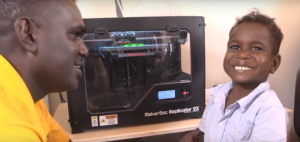In the central North Pacific Ocean, there is a giant floating patch of garbage known, appropriately, as the Great Pacific Garbage Patch. Mostly comprised of plastic waste, it was formed, scientists believe, by ocean currents that gradually pulled discarded garbage into a floating clump.
The mass of garbage has had a tragic effect on ocean wildlife, and has affected humans as well, who ingest the plastic chemicals when they eat fish that have swallowed bits of plastic. The only solution to this problem is simply to stop throwing away so much plastic, which unfortunately is much easier said than done.
One thing that 3D printing has provided is an excellent means for recycling plastic, and 3D printing companies such as Fila-Cycle are making great strides towards reducing waste as much as possible by turning plastic waste into filament. But it’s not just corporations that are capable of transforming trash into printing materials.

The island of Milingimbi sits off the coast of Arnhem Land in Australia’s Northern Territory. It is home to the indigenous Yolngu community, the members of which have just learned about 3D printing. Lisa Somerville, project coordinator for the Arnhem Land Progress Association, came up with an initiative earlier this year to simultaneously clean up the island’s trash, teach children about technology, and give them a reason to be excited about learning.
“We wanted to create an incentive for kids who go to school 100 per cent of the time and build on that,” Somerville said.
 The
program, which the community has dubbed “Plastic Fantastic,” has
engaged the whole community, not just the children. Leandra Dhurrkay and
Jason Wandji, Milingimbi school officers, have been working with
students, council workers, and other community members to collect the
numerous pieces of plastic waste lying around the island. While
gathering the material, the participants learn about recycling and the
various types of recyclable plastic.
The
program, which the community has dubbed “Plastic Fantastic,” has
engaged the whole community, not just the children. Leandra Dhurrkay and
Jason Wandji, Milingimbi school officers, have been working with
students, council workers, and other community members to collect the
numerous pieces of plastic waste lying around the island. While
gathering the material, the participants learn about recycling and the
various types of recyclable plastic.“There is lots of plastic around the community,” Dhurrkhay said. “At every camp and in every street there are plastic bottles lying around. It is good that we are using all that.”The plastic is then shredded, melted, and extruded into filament, which is then used in the school’s 3D printer. Students learn about 3D printing and digital design while making sunglasses, iPhone holders, and small plastic toys. According to Somerville, the children have been having a great time with the program. One of the major goals was to give the kids an incentive to want to go to school, which has, so far, been a success. It has been educational for the adults, as well.
“I have just learned a little bit about using the computer and 3D program. This is the first time I have used computers,” said Wandji. “It’s good for elders to sit with children, care for them, and teach them this way.”Just a few weeks ago, Project Plastic Fantastic was presented the Environmental Innovation Award for turning plastic rubbish into 3D printed toys.

No comments:
Post a Comment
Note: Only a member of this blog may post a comment.